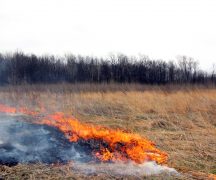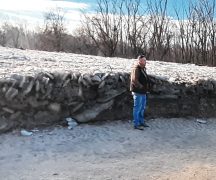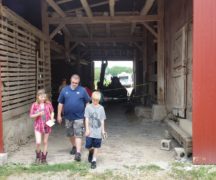By JAN LARSON McLAUGHLIN
BG Independent News
The Wood County Park District has agreed to play a role in a local sanctuary for butterflies, bees and birds.
The park board voted unanimously Tuesday to maintain the 13.4-acre “solar sanctuary” planned around the solar field near the corner of Newton and Carter roads, northeast of Bowling Green.
The project fits nicely into the mission of the park district, according to Neil Munger, executive director of the district. In exchange for maintaining the site, the park district can use the wildflower sanctuary as an educational tool.
“It’s been an ongoing issue around the country – the loss of pollinator habitat,” Munger said.
The city of Bowling Green is working with the U.S. Fish & Wildlife Service to develop a wildlife and pollinator habitat around the new 165-acre solar field.
One goal of the wildlife habitat area is to bring back pollinators to the region. Adult Monarch butterflies have seen a 50 percent drop in the last 10 years due to disappearing milkweed plants – which are the only plants used by Monarchs for laying eggs.
Some wildflower habitats target specific species. The one at Bowling Green’s solar site will be aimed at attracting several species of bees, birds and butterflies. The plan calls for three seasons of blooming plants.
The wild habitat area, which will be planted outside the fenced-in solar array, is intended to benefit various pollinators, crops, soil quality, water quality, foraging birds and Monarchs.
Ohio is a priority location for Monarchs on their annual trek to Mexico.
This region also has many crops that are suffering from inadequate pollination. Crops relying on pollination include tomatoes, blueberries, melons, soybeans, peppers, peaches, cucumbers, squash and apples.
Honey bees account for more than $15 billion in agricultural production of fruits, vegetables and nuts.
Water and soil quality are also helped by the wildflower habitats because the native plants have deeper root systems and add nitrogen to the soil. The plants also attract insects, which are a food staple for many birds, and provide bird nesting areas in tall grasses.
The wildlife habitat will be a team project of the U.S. Fish & Wildlife Service, the City of Bowling Green, Next Era Energy, American Municipal Power, and Bowling Green State University.
The final partner to sign on was the park district, which will maintain the site and use it as part of its educational programming. Maintenance basically means mowing the site once a year, Munger said.
The U.S. Fish and Wildlife Service officials hope to plant the site this year.
In other business at the park district meeting, the board welcomed new members Bill Cameron from North Baltimore, Tom Myers from Perrysburg, and Sandy Wiechman from Bowling Green.
The board re-elected Denny Parish as chairman and Bob Hawker as vice chairman. The board decided to continue meeting on the second Tuesday of each month, at 3 p.m. During the winter months, the meetings will be held at the park district headquarters on Mercer Road. During the warmer months, the meetings will move to various parks in the county.
Also at the meeting, Munger updated the board on the American Electric Power easement request to run poles along the Slippery Elm Trail near North Baltimore. Prior to Tuesday’s park board meeting, Munger heard from AEP that the project was on hold.
Munger has already expressed concerns about the easement since it would require that all the trees along the west side of the trail be removed and that the electric poles be placed close to the trail, which could pose a hazard.
“I was approached by a number of members of the public,” who shared the concerns about losing trees along the trail, Munger said.
In other business, Jim Witter, park district program coordinator, talked about some of the new programs planned by the park district. There will be more adult education programs, including one on winter camping, one on do-it-yourself geocaching, and another on frog calls.
The district will also be partnering with more “expert speakers,” such as someone from the Toledo Zoo to talk about the reintroduction of sturgeon into the Maumee River.
Witter also answered board questions about winter use of park ponds. He said there are message signs that flip to let people know if the ice is safe for activities like hockey and skating on the W.W. Knight Preserve pond. Ice fishing is not allowed unless it’s part of a programming activity.





